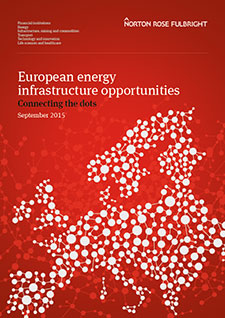How does the Juncker plan link in with the Energy Union and how does the Cohesion Fund interact with the Projects of Common Interest? Are the new guidelines from EIOPA relevant to energy infrastructure and where does the Capital Markets Union fit in?
Over the last couple of years, there has been a flurry of activity from the European Commission and the agencies of the European Union, particularly in the energy market. We have seen the launch of the Projects of Common Interest, the Juncker Plan, the Energy Union and the Capital Markets Union. As investors, financiers and other stakeholders start to appreciate that there might be more than just words to these initiatives, they quickly realise that it is difficult to get to grips with how the initiatives interact with each other and with other, already existing, support initiatives.
Very sizeable investments are required to meet the European 2020 targets and even larger amounts of money will be required to meet the even tougher 2030 targets. In the energy and energy infrastructure space, there is €5.85 billion from the Connecting Europe Facility, potentially €240 billion of the €315 billion Juncker plan and a whole framework provided under the Energy Union to support growth and investment. At the same time, what used to be a wall of debt has been replaced by a wall of funds, with infrastructure funds, pension funds and financial institutions looking to provide capital. However, there is a disconnect between the funds available and the projects that need funding.
With the European Council having approved the Energy Union in March, the European Parliament having approved the Juncker plan in June and the third round of calls for PCI funding due in September, there is certainly momentum. To maintain this momentum, however, it is important that the stakeholders understand the interaction and see the pipeline of opportunities. As a number of single initiatives, it is not unlikely that they will fail; a siloed approach – where the energy initiative is separated from the capital markets initiative for example – is bound to fail. Taken together, however, they may well work.
We believe that these investment initiatives for Europe could assist in creating significant opportunities for investors, financiers, governments, promoters and contractors on a global scale. Investors worldwide, particularly pension and insurance funds, are looking for predictable returns, both as equity investors and debt providers. Faced with a more benign monetary policy environment and low interest rates together with a requirement for long-term investments in infrastructure, and attracted by a combination of relative value, low but stable yield, long-term matching of asset and liability and benefits of diversifying portfolios, a growing number of institutional investors are seeking to invest in infrastructure debt and equity. At the same time, many banks that had previously curtailed long-term lending are now back, which, together with several new-entrant banks, are particularly targeting ancillary income opportunities. Matching the availability of abundant funds with a willingness to explore innovative, but risk-mitigated, structures and viable projects will create opportunities.
Understanding the whole picture is paramount; however investors, project promoters and other stakeholders find it difficult to navigate the labyrinth of European initiatives. This briefing explains the programmes and initiatives, connects the dots and looks at them in the context of managing risk and finding finance against the regulatory backdrop.





